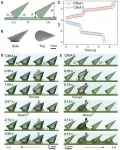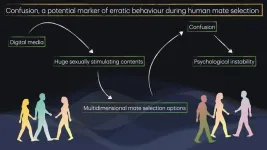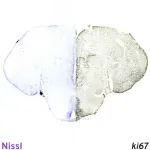(Press-News.org) New research finds that artificial light at night (ALAN) attracts larval fish away from naturally lit habitats, while dramatically lowering their chances of survival in an “ecological trap”, with serious consequences for fish conservation and fishing stock management.
“Light pollution is a huge ongoing subject with many aspects that are still not well understood by scientists,” says Mr Jules Schligler, a PhD student at CRIOBE Laboratory (Centre de Recherches Insulaires et Observatoire de l’Environnement) in Moorea, French Polynesia.
ALAN is the product of human-related activities such as the use of electrical lights along roads, factories, residences and resorts near bodies of water. “ALAN is everywhere and marine wildlife is not exempt to its effects,” says Mr Schligler. “A quarter of the world coastline is impacted and this level is increasing every year.”
Mr Schligler and his team set out to investigate the effects of ALAN on larval recruitment in tropical fish. Larval recruitment is the number of fish that settle in their habitat and survive their juvenile years before becoming an adult. “Larval recruitment is a key life history trait for fish that impacts on stock replenishment and adult fitness,” he says. “Larval fish are also very dependent on the natural light cycle.”
To investigate these effects, Mr Schligler used 48 corals that were split into two treatments: control corals with only natural light exposure, and ALAN corals that were exposed to light pollution at night of a similar intensity that beach resorts and streetlights produce. They focused on two dominant coral reef damselfish native to French Polynesia, the yellowtail dascyllus (Dascyllus flavicaudus) and the blue-green chromis (Chromis viridis).
“First, we monitored fish settlement to the corals to see if they preferred natural or artificial light conditions,” says Mr Schligler. “The fish were then subjected to a range of experiments to better understand the impact of ALAN after they had settled.” These experiments measured various aspects of development and survival such as growth, metabolic rate and risk of predation.
This research finds that many young fish actually prefer environments with artificial light, recruiting 2-3 times as many fish than naturally lit environments.
The study also reveals the harmful effects of ALAN on fish growth, metabolic rate and overall survival. “ALAN has produced an ecological trap where these fish, misled by human activity, now prefer habitats where their fitness will be lower,” says Mr Schligler. “In other words, ALAN has the potential to attract organisms to a less suitable environment, generating a peculiar anthropogenic stressor."
These results have implications for fish conservation and harvesting policies. “Marine protected areas have only started to consider light pollution in their management policy very recently,” says Mr Schligler. “To better understand fish stock replenishment and conservation, it is crucial to take into account as many factors as we can, such as the rarely considered effects of light pollution.”
This research is being presented at the Society for Experimental Biology Annual Conference in Prague on the 2-5th July 2024.
END
Artificial light is a deadly siren song for young fish
2024-07-03
ELSE PRESS RELEASES FROM THIS DATE:
Social media is a likely cause of ‘confusion’ in modern mate selection
2024-07-03
A recent sociological study finds that most young adults surveyed reported feeling confused about their options when it comes to dating decisions. Preliminary analysis suggests that more than half of young people experience confusion about choosing life-partners, with women appearing to be more likely to report partner selection confusion than men.
Due to the pervasiveness of social media and digital dating in everyday lives, humans are now exposed to many more potential mates than ever before, but the availability of popular dating apps ...
Exploring bird breeding behaviour and microbiomes in the radioactive Chornobyl Exclusion Zone
2024-07-03
New research finds surprising differences in the diets and gut microbiomes of songbirds living in the radiation contaminated areas of the Chornobyl Exclusion Zone, Ukraine. This study is also the first to examine the breeding behaviour and early life of birds growing up in radiologically contaminated habitats.
The Chornobyl Exclusion Zone (Ukrainian), also known as the Chernobyl Exclusion Zone (Russian), is an area of approximately 2,600 km2 of radiologically contaminated land that surrounds the Chornobyl Nuclear Power Plant. The levels of contamination are uneven throughout the zone.
“The ...
Discovering new anti-aging secrets from the world’s longest-living vertebrate
2024-07-03
New experimental research shows that muscle metabolic activity may be an important factor in the incredible longevity of the world’s oldest living vertebrate species – the Greenland shark. These findings may have applications for conservation of this vulnerable species against climate change or even for human cardiovascular health.
Greenland sharks (Somniosus microcephalus) are the longest living vertebrate with an expected lifespan of at least 270 years and possible lifespan beyond 500 years. “We want to understand what adaptations ...
Pregnant fish can also get “baby brain”, but not the way that mammals do
2024-07-03
New research reveals that pregnancy-related brain impairment is present in live-bearing fish, but instead of affecting learning and memory as expected from similar research on mammals, it appears to have a stronger impact on decision-making and sensory reception.
There have been many studies into the detrimental impact of pregnancy on mammalian brains, sometimes called “baby brain” or “momnesia” in humans, revealing how the disruption of neurological processes like neurogenesis, or the creation ...
Pasteurization inactivates highly infectious avian flu in milk
2024-07-03
Highlights:
• In late March 2024, H5N1 bird flu was detected in dairy cattle and then in raw milk.
• Researchers tested hundreds of milk products from dozens of states for the virus.
• No infectious virus was found in pasteurized milk products.
• Non-infectious traces of viral genetic material were found in 20% of samples.
Washington, D.C.—In March 2024, dairy cows in Texas were found to be infected with highly pathogenic avian flu, ...
KIER develops 'viologen redox flow battery' to replace vanadium’
2024-07-03
A technology has been developed to replace the active material in large-capacity ESS 'redox flow batteries' with a more affordable substance.
*Redox Flow Battery: A term synthesized from Reduction, Oxidation, and Flow. It is a battery that stores electrical energy as chemical energy through oxidation and reduction reactions of active materials in the electrolyte at the electrode surface and converts it back to electrical energy when needed. It is capable of large-scale storage, can be used long-term through periodic replacement of the electrolyte, and its major advantage is the absence of fire risk.
Dr. Seunghae Hwang’s ...
Chemists synthesize an improved building block for medicines
2024-07-03
Chemists have overcome a major hurdle in synthesizing a more stable form of heterocycle—a family of organic compounds that are a common component of most modern pharmaceuticals.
The research, which could expand the toolkit available to drug developers in improving the safety profiles of medications and reducing side effects, was published in Science by organic chemists at the University of British Columbia (UBC), the Massachusetts Institute of Technology (MIT), and the University of Michigan.
“Azetidines ...
A genetic algorithm for phononic crystals
2024-07-03
Tokyo, Japan – The advent of quantum computers promises to revolutionize computing by solving complex problems exponentially more rapidly than classical computers. However, today's quantum computers face challenges such as maintaining stability and transporting quantum information. Phonons, which are quantized vibrations in periodic lattices, offer new ways to improve these systems by enhancing qubit interactions and providing more reliable information conversion. Phonons also facilitate better communication ...
Machine learning could aid efforts to answer long-standing astrophysical questions
2024-07-03
In an ongoing game of cosmic hide and seek, scientists have a new tool that may give them an edge. Physicists at the U.S. Department of Energy’s (DOE) Princeton Plasma Physics Laboratory (PPPL) have developed a computer program incorporating machine learning that could help identify blobs of plasma in outer space known as plasmoids. In a novel twist, the program has been trained using simulated data.
The program will sift through reams of data gathered by spacecraft in the magnetosphere, the region of outer space strongly affected by Earth’s ...
Research spotlight: Uncovering how a cellular miscommunication leads to cognitive impairment in female patients with Alzheimer’s disease
2024-07-03
Lead author Neta Rosenzweig, PhD, of the Ann Romney Center for Neurological Diseases, and senior author Oleg Butovsky, PhD, of the Ann Romney Center and Gene Lay Institute of Immunology and Inflammation, share key messages from their paper “Sex-Dependent APOE4 Neutrophil-Microglia Interactions Drive Cognitive Impairment in Alzheimer’s Disease” published in Nature Medicine.
How would you summarize your study for a lay audience?
In this manuscript, we identify that a major genetic risk ...








